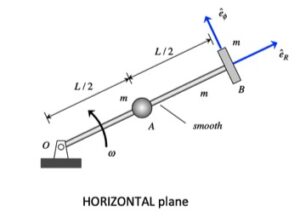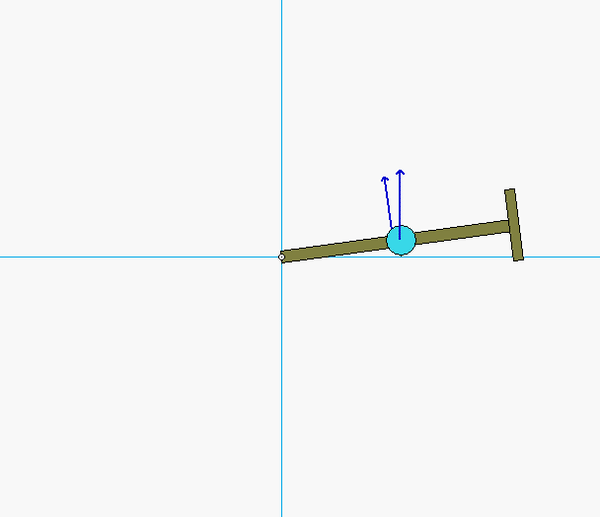| Problem statement Solution video |
DISCUSSION THREAD

Any questions?? Please ask/answer questions regarding this homework problem through the "Leave a Comment" link above.
DISCUSSION

Four-step plan
Step 1: FBD
Draw a free-body diagram particles A and B, along with the bar, altogether. Is angular momentum for this system conserved? Why, or why not?
Step 2: Kinetics - Angular impulse/momentum
Write down the angular momentum for A, B and the bar individually, and then add together. For a particle A, for example, recall that angular momentum is given by HO = m rA/O x vA. For a rigid body, HO = IOω. You will also need the coefficient of restitution equation relating the radial (normal components here) components of velocity of A and B during impact.
Step 3: Kinematics
For writing down the velocity of points A and B, a polar description is recommended. For example, vA = R_dot eR + Rωeθ.
Step 4: Solve
Solve your equations from Steps 2 and 3 for the velocity of P. Do not forget that A will have both radial and transverse components of velocity.
For the system of the block+bar+ball there is no nonconservative work done on the system, and the angular momentum is conserved since the reaction force is through the fixed point. In addition, we have the value for e and we know the linear momentum in the e_theta direction is conserved. Thus we will be using work energy and Impulse linear and angular momentum formulas for this problem. Use work energy and linear impulse momentum formulas to find the velocity of a in the e_r direction, and use impulse angular momentum to find the velocity of a in the e_theta direction.
Does it mean that we neglect gravity in our linear momentum equation?
Yes this means you can neglect gravity.
Also do not forget to include the mass of the bar in the problem, that's pretty much the only thing different from the earlier Ch 4 homework we did
One thing that I was wondering is if after impact are we assuming that A is located at B's original location? Is rA/O after impact equal to L eR?
Yes, immediately after impact, A is at the same location as is B.
Are we to assume that A initially only has velocity in the e_phi direction?
Yes, this is what I assumed to solve the problem. A is at the midpoint of the bar when the bar has an initial rotation rate of w1. The problem statement says "after which A slides outward on the bar" showing that there is no initial e_R velocity for A.
It was useful for me to define 3 separate time stamps- initial state, immediately before the collision, and immediately after the collision
In order to solve for the velocity of A in the "R" direction, I've written a work-energy equation. When I write the state 2 (just before particle A hits particle b) final energy term for particle A, I'm planning to include both the moment of inertia term and the velocity term (i.e. 1/2*I*omega^2 + 1/2*m*Va^2 instead of just 1/2*I*omega^2). I'm including the term because I know the moment of inertia term does not account for Particle A's velocity in the "R" direction. However, I feel it's a little unclear on when to write this extra velocity term in the work-energy equation. What are the conditions to do so?
I think since A is a particle there is no term with moment of inertia. So for A it would just be 1/2*m*Va^2
This problem is very similar to homework H4.S, however the bar now has a component in the angular momentum and work energy equations.
I assume there will be a new angular velocity when particle A reaches particle B?
Yes, because the particle moves farther from the center of rotation the moment of inertia increases, decreasing the angular velocity
is it correct to assume the rotation is in the horizontal plane?
disregard
How should we go about knowing which states of the collisions we should model in our FBDs?
I found it useful to do two FBDs, one of the whole system before the collision between A and B and one for A and B directly after the impact. This helped me to realize where momentum is conserved for the whole system and also just better understand the problem. Hope that helped!
One thing to keep in mind when writing the angular momentum equations is that the velocity only needs to account for the e_theta direction (which is R times omega) since it is a cross product with the radial distance which is e_R.
This problem is the same as HW H.4.S, but the bar has mass this time. For this, remember to add that component for the bar in your angular momentum and kinetic energy equations.
Does the moment of inertia about O include the mass of the particles or just the bar?
The kinetic energy is calculated separately for the bar and each of the particles. Because they are separate, only the moment of inertia of the bar itself is used to calculate the bar's rotational kinetic energy (1/2*I*w^2). This is similar to how you would not use the mass of particles A and B to calculate the translational kinetic energy of the bar (1/2*m*v^2).
I believe we need to use angular momentum of both the bar, B, and A since they all have mass and velocity. And then use the work energy equation to solve for Va
It's easy to do this problem by making the free body diagrams simple. I set up a before and after FBD of the system consisting of A and B, and can see that momentum is conserved
Should we break this up into 3 time periods and look at it from the starting point to the moment before impact, and then the moment before impact to the moment after impact?
Yes, I broke this up into 2 time periods. 1 to 2 and 2 to 3. I solved it almost the exact same as H.4.5. I used linear momentum for 1 to 2 and 2 to 3. I also used work energy for 1 to 2. Then I used COR for 2 to 3. I needed to use work energy and COR to get additional equations because there were too many unknowns and too little equations.
Hi guys! It's extremely important to identify 3 different states in this problem in order to solve correctly. I chose before impact, right before impact, and during impact.
I think it is very helpful to define them as two separate particles in three different states. This allowed me to easily work through the variables in the equation.